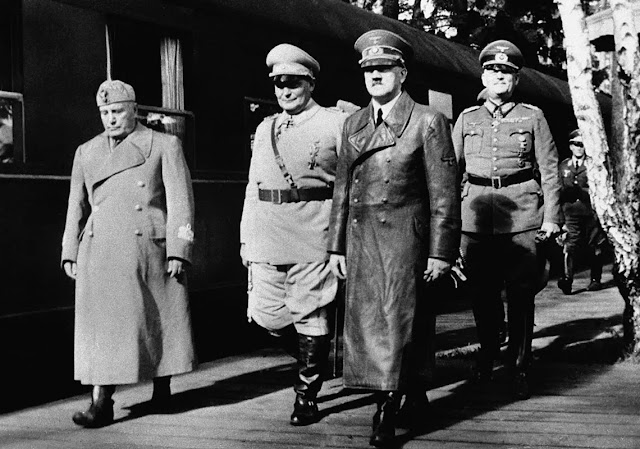As the tides of World War II turned against Germany, many of Adolf Hitler’s top generals realized long before the fall of Berlin that defeat was inevitable. Despite fierce propaganda, blind loyalty from some quarters, and Hitler’s increasingly delusional leadership, a significant portion of the German military command understood the reality of the situation — yet they either felt powerless to stop it, trapped by fear, or continued to fight in hopes of negotiating better terms.
 |
The story of Hitler’s generals facing the slow collapse of the Reich is a tale of military frustration, internal plotting, and tragic inevitability.
Early Hints: The Failure of Operation Barbarossa
The German invasion of the Soviet Union in June 1941 — Operation Barbarossa — was a massive gamble. When it launched, Hitler’s generals were confident of a quick victory. But by late 1941, as the brutal Russian winter set in and German forces became bogged down outside Moscow, doubts began creeping into the minds of many high-ranking officers.
Generals like Heinz Guderian, the father of German armored warfare, realized the campaign had overreached. He warned that the Wehrmacht lacked the resources for a prolonged war against the Soviet Union. Guderian even directly challenged Hitler during strategic meetings — a move that eventually led to his dismissal.
By 1942, with the failed offensive at Stalingrad looming, many within the German High Command privately admitted that a full military victory was slipping away.
Stalingrad: The Point of No Return
The catastrophic defeat at Stalingrad (winter 1942–1943) was a major turning point. Hitler had ordered the Sixth Army, under Friedrich Paulus, to hold the city "to the last man," forbidding retreat.
Generals like Erich von Manstein proposed realistic plans to rescue the trapped Sixth Army, but Hitler stubbornly refused, prioritizing ideological goals over military logic.
When Paulus surrendered in February 1943, taking nearly 90,000 men into Soviet captivity, the German High Command understood with grim clarity:
The Eastern Front could not be stabilized.
Germany could not replace such massive losses.
Defeat was now a question of when, not if.
Inner Resistance: The Plotting Begins
Knowing defeat was on the horizon, some German officers began to consider removing Hitler from power.
By 1943, figures like Claus von Stauffenberg, Henning von Tresckow, and Ludwig Beck (a retired general) concluded that Hitler had become a liability not just to Germany’s war effort, but to its very survival. They hoped that by assassinating Hitler and negotiating peace with the Allies, they could salvage something of the nation’s future.
This led to several assassination attempts, culminating in the famous July 20, 1944 Plot, where Stauffenberg placed a bomb at Hitler’s headquarters (the "Wolf’s Lair"). The bomb exploded but failed to kill Hitler. The failed plot resulted in a brutal crackdown; hundreds of officers and civilians were executed in retaliation.
Despite the conspiracy’s failure, it is clear that many generals knew by mid-1944 that Germany’s defeat was inevitable.
D-Day and the Western Front Collapse
The Allied invasion of Normandy on June 6, 1944, dealt another devastating blow.
Generals like Erwin Rommel, the famed "Desert Fox," quickly realized the war was lost once the Allies secured a foothold in France. Rommel reportedly said to colleagues,
"The war itself is lost. The only thing left is to negotiate the best possible terms."
Rommel even made discreet attempts to open communication with the Allies through intermediaries. His growing disillusionment with Hitler contributed to his forced suicide later that year, when his connection to the anti-Hitler plotters came under suspicion.
Hitler's Delusion vs. Military Reality
As defeat loomed larger, Hitler retreated further into fantasy. He believed in "miracle weapons" like the V-2 rockets and imagined divisions that no longer existed would somehow repel the advancing Soviet and Allied forces.
Generals such as Gerd von Rundstedt, Albert Kesselring, and Walther Model became increasingly frustrated trying to implement orders based on hallucinations rather than reality. Rundstedt famously snapped during a briefing in 1945, saying,
"Make peace, you fools!" — a cry that encapsulated the despair of the professional military class.
Many generals continued fighting, not because they believed in victory, but because:
They feared brutal Soviet retribution.
They hoped to surrender to the Western Allies instead of the Soviets.
They were trapped in Hitler’s web of fear and loyalty.
The Final Collapse
By early 1945, as the Allies crossed the Rhine and the Soviets smashed into eastern Germany, the generals were effectively powerless. Hitler forbade strategic withdrawals, demanded suicidal counterattacks, and purged officers who even hinted at retreat.
Generals who surrendered without explicit orders, such as those defending the Ruhr or parts of Austria, were branded traitors. Some, like Field Marshal Ferdinand Schörner, stayed fanatically loyal to Hitler until the bitter end, even as others desperately sought surrender to the Americans.
When Hitler finally killed himself in April 1945, the remaining German High Command (now under Admiral Karl Dönitz) attempted to end the war with the West while still resisting the Soviets — a futile gesture that ended days later with Germany’s unconditional surrender on May 8, 1945.